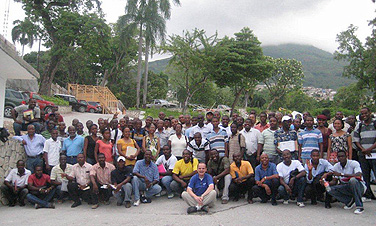News
A major step toward rebuilding

Andre Filiatrault, seated in front, poses with participants in the Earthquake Engineering Educational Seminar. Pierre Fouché, a Haitian native and UB doctoral candidate in earthquake engineering, is far right in the first standing row.
At a university campus in Port-au-Prince where not a single building withstood the January earthquake, more than 200 Haitian engineers, architects and other professionals gathered in tents last weekend in temperatures hovering near 100 degrees to begin learning the principles of earthquake-resistant design.
The gathering was the first Earthquake Engineering Educational Seminar, jointly-sponsored by UB’s MCEER and Université Quisqueya (UniQ).
The three-day seminar was a result of a memorandum of understanding signed between MCEER (formerly the Multidisciplinary Center for Earthquake Engineering Research) and UniQ, a private university in Port-au-Prince, to bring MCEER’s earthquake-engineering expertise to the professional and student engineering communities in Haiti so they can learn fundamental earthquake-engineering principles in order to retrofit damaged facilities and design new construction.
The response to this first seminar was overwhelming, organizers say.
“We expected between 60 and 70 attendees and we got 215,” says Andre Filiatrault, MCEER director and UB professor of civil, structural and environmental engineering, who ran the seminar.
“The attitude of the engineers was extremely positive,” he says, “They realize that they need to become proficient in this type of engineering and there is a thirst to learn.”
Within eight days of the Jan. 12 earthquake, Filiatrault had assembled and deployed the first team of structural engineers to Haiti to conduct building-safety inspections at the request of the United Nations. When team members returned to the U.S., they knew more needed to be done.
The relationship between MCEER and UniQ, which will extend for at least three years, is designed to help Haiti establish its own community of earthquake engineers to mitigate earthquake-induced damage to its buildings. Each seminar will provide credit toward a master’s degree in earthquake engineering that UniQ is developing with MCEER’s support.
The popularity of this first seminar prompted sponsors to divide participants into two groups, with Filiatrault teaching one and Pierre Fouché, a Haitian native and UB doctoral candidate in earthquake engineering, teaching the other. Sofia Tangalos, MCEER education and outreach officer and information service director who lived in Haiti as a child, provided on-site organizational support.
The seminar was conducted completely in French.
“This is the best thing that we can do for Haiti: to start educating the architects and engineers about the fundamental notions of earthquake engineering so that they can avoid past mistakes,” Filiatrault says.
After an introduction by Fouché about the seismology and seismicity of Haiti, the seminar focused on an introduction to the principles of earthquake-resistant design and on the ATC-20 (Applied Technical Council) Rapid Building Assessment Methodology.
“A key advantage of the seminar was its emphasis on field studies, as well as classroom-type instruction,” Filiatrault says. All attendees were able to participate in field assessments of earthquake-damaged buildings in Port-au-Prince to see firsthand the impact of earthquakes on structures lacking the necessary earthquake-engineering detailing, and to learn how to conduct damage assessments on structures throughout Port-au-Prince that have yet to be inspected.
“We gave attendees a firm grounding in the concepts of earthquake engineering and some really practical information on how to build better buildings even without making detailed calculations,” he says. “We showed them the differences between what makes a building safe or unsafe. When they begin to apply even just those principles to their engineering and architectural practices, it will make a tremendous difference.”
In his presentation, Filiatrault cited Chile’s 1960 earthquake as a parallel example.
“I wanted to highlight the fact that Haitian engineers are not alone and that what they are going through has been experienced by other countries,” he says. “That 1960 earthquake in Chile caused tremendous suffering and loss of life, and it served as a turning point where things started to change. In the same way, I told them Jan. 12, 2010, can also represent a change in paradigm for Haiti.”
Subsequent seminars will focus on the specific calculations that are required to construct safe buildings, a segment that is largely missing from current engineering curricula in Haiti.
The next seminar, which will last for five days, will take place in early September. Additional faculty from other U.S. engineering schools will be involved.
“The goal is to develop with UniQ an earthquake-engineering curriculum–the first in Haiti and in the francophone region of the West Indies, including the islands of Martinique and Guadeloupe,” notes Tangalos. “There is much that needs to be learned–not just in the lack of building codes, but also in the understanding of the proper building materials and construction methods.”
The MCEER-UniQ partnership also will develop longer-term educational programs on seismic design of buildings with a focus on adapted techniques for reconstruction, as well as promote academic exchange and cooperation over the next three years.

Reader Comments